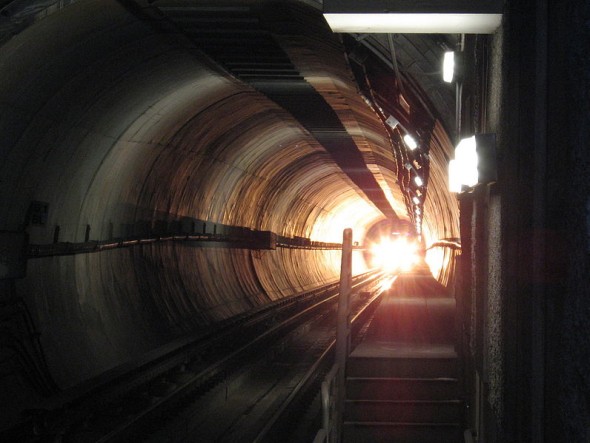TakePart | April 4, 2014
Here’s a next-gen idea that’ll blow you away: Using a specialized turbine during a 10-day period in August and September 2013, the Los Angeles Metro rail system was able to capture the wind power coming from passing subway cars—and turn it into renewable energy.
The 10-foot-wide wind turbine—custom-built for the project, which was initiated by Metro’s Environmental Compliance unit—generated an average of 77.7 kwH per day, an amount that could produce 28,000 kwH if projected over an entire year. That’s enough to power 12 homes in California during the same time period, or prevent the annual release of more than 17 tons of CO2 emissions from natural gas (and more than 30 tons of CO2 emissions generated from coal), according to Metro estimates.
“To our knowledge, Metro is the first transit agency to have implemented an actual test and have real data to report,” said Metro spokesperson Anna Chen. University students in India got permission to install a turbine in Delhi’s subway system last year, and a team of Korean designers floated the idea in 2010, but no results have been publicly released to date.
The turbine—known as MACE (multi-blade mass airflow collection equipment)—was designed by WWT Tunnel, a Pasadena, Calif.–based company that develops technology aimed at generating energy from previously unused sources.
It took a few months to design the equipment and several days for Metro to install the MACE unit, Chen said. Because Metro trains run for up to 20 hours a day and the subway system often undergoes repairs in the lull between operations, there was only a three- to four-hour window each day to install the unit without interrupting subway service.
The MACE turbine was placed on the base of a tunnel wall on Metro’s Red Line between the North Hollywood and Universal City stations and was removed after the pilot project was complete. The agency chose to install it at a middle section of the tunnel, where trains are estimated to run up to 70 miles per hour.
“It’s the best place to get the maximum amount of wind because as the train leaves the station, the wind pushes out before it, and then the train creates the drag,” Chen said.
MACE’s blades start spinning a minute before the train passes by and stop two minutes after the train passes. During the pilot, the unit made more than 1,070 revolutions per minute.
To make sure that the blades could safely operate once underground, Metro and WWT Tunnel conducted aboveground testing in which the turbine was run through a series of wind simulations.
“They wanted to make sure that nothing broke off if the blades spun at maximum speeds,” Chen said.
Metro anticipates that it can store any excess wind energy produced by the turbines for use during times of peak demand. Because the trains run on a regular schedule, the underground wind energy can be a more reliable source of renewables than solar or aboveground wind.
But Metro is not ready to regularly start spinning the blades yet. Using the data collected during the pilot, it will release a report later in the year that will analyze the feasibility of the idea, as well as the effectiveness of MACE turbines.
“We’ll be making recommendations on how we can implement this throughout the system as a whole,” Chen said.
View the original story here.
Photo of Los Angeles Metropolitan Transportation Authority subway train in tunnel via Wikimedia Commons
